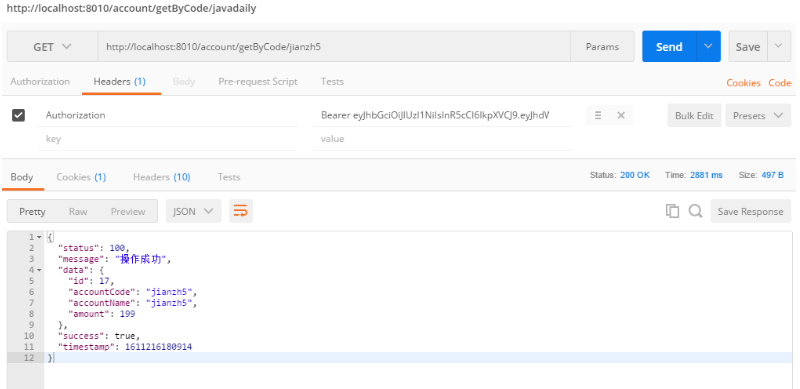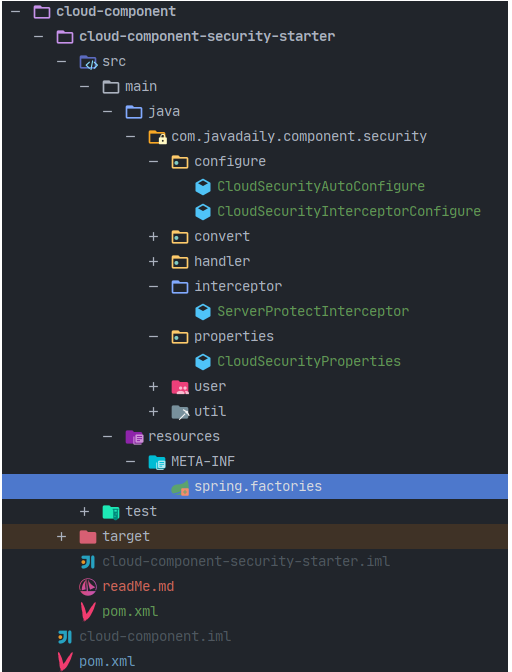

SpringCloud Alibaba微服务实战二十七 - 禁止直接访问后端服务
source link: https://my.oschina.net/u/1388595/blog/4949701
Go to the source link to view the article. You can view the picture content, updated content and better typesetting reading experience. If the link is broken, please click the button below to view the snapshot at that time.


使用SpringCloud架构后我们希望所有的请求都需要经过网关才能访问,在不作任何处理的情况下我们是可以绕过网关直接访问后端服务的。如下,我们绕过网关直接访问后端服务也是可以获取到数据的。

那我们今天的议题就是 如何防止请求绕过网关直接访问后端服务?
我觉得防止绕过网关直接请求后端服务的解决方案主要有三种:
-
使用Kubernetes部署
在使用Kubernetes部署SpringCloud架构时我们给网关的Service配置NodePort,其他后端服务的Service使用ClusterIp,这样在集群外就只能访问到网关了。
-
后端普通服务都部署在内网,通过防火墙策略限制只允许网关应用访问后端服务。
-
应用层拦截
请求后端服务时通过拦截器校验请求是否来自网关,如果不来自网关则提示不允许访问。
这里我们着重关注在应用层拦截这种解决方案。
实现思路其实也很简单,在请求经过网关的时候给请求头中增加一个额外的Header,在后端服务中写一个拦截器,判断请求头是否与在网关设置的请求Header一致,如果不一致则不允许访问并给出提示。
当然为了防止在每个后端服务都需要编写这个拦截器,我们可以将其写在一个公共的starter中,让后端服务引用即可。而且为了灵活,可以通过配置决定是否只允许后端服务访问。
接下来我们看看核心代码。(代码中涉及 SpringBoot 编写公共Starter的套路,相信看过我博客的同学肯定是会的,因为之前文章有详细说过。)
-
在网关
cloud-gateway模块编写网关过滤器
@Component
@Order(0)
public class GatewayRequestFilter implements GlobalFilter {
@Override
public Mono<Void> filter(ServerWebExchange exchange, GatewayFilterChain chain) {
byte[] token = Base64Utils.encode((CloudConstant.GATEWAY_TOKEN_VALUE).getBytes());
String[] headerValues = {new String(token)};
ServerHttpRequest build = exchange.getRequest()
.mutate()
.header(CloudConstant.GATEWAY_TOKEN_HEADER, headerValues)
.build();
ServerWebExchange newExchange = exchange.mutate().request(build).build();
return chain.filter(newExchange);
}
}
在请求经过网关时添加额外的Header,为了方便这里直接设置成固定值。
-
建立公共Starter模块
cloud-component-security-starter

- 编写配置类,用于灵活控制服务是否允许绕过网关
@Data
@ConfigurationProperties(prefix = "javadaily.cloud")
public class CloudSecurityProperties {
/**
* 是否只能通过网关获取资源
* 默认为True
*/
private Boolean onlyFetchByGateway = Boolean.TRUE;
}
- 编写拦截器,用于校验请求是否经过网关
public class ServerProtectInterceptor implements HandlerInterceptor {
private CloudSecurityProperties properties;
@Override
public boolean preHandle(@NonNull HttpServletRequest request, @NonNull HttpServletResponse response, @NonNull Object handler){
if (!properties.getOnlyFetchByGateway()) {
return true;
}
String token = request.getHeader(CloudConstant.GATEWAY_TOKEN_HEADER);
String gatewayToken = new String(Base64Utils.encode(CloudConstant.GATEWAY_TOKEN_VALUE.getBytes()));
if (StringUtils.equals(gatewayToken, token)) {
return true;
} else {
ResultData<String> resultData = new ResultData<>();
resultData.setSuccess(false);
resultData.setStatus(HttpServletResponse.SC_FORBIDDEN);
resultData.setMessage("请通过网关访问资源");
WebUtils.writeJson(response,resultData);
return false;
}
}
public void setProperties(CloudSecurityProperties properties) {
this.properties = properties;
}
}
- 配置拦截器
public class CloudSecurityInterceptorConfigure implements WebMvcConfigurer {
private CloudSecurityProperties properties;
@Autowired
public void setProperties(CloudSecurityProperties properties) {
this.properties = properties;
}
@Bean
public HandlerInterceptor serverProtectInterceptor() {
ServerProtectInterceptor interceptor = new ServerProtectInterceptor();
interceptor.setProperties(properties);
return interceptor;
}
@Override
public void addInterceptors(InterceptorRegistry registry) {
registry.addInterceptor(serverProtectInterceptor());
}
}
- 编写starter装载类
@EnableConfigurationProperties(CloudSecurityProperties.class)
public class CloudSecurityAutoConfigure{
@Bean
public CloudSecurityInterceptorConfigure cloudSecurityInterceptorConfigure() {
return new CloudSecurityInterceptorConfigure();
}
}
- 建立资源文件spring.factories,配置Bean的自动加载
org.springframework.boot.autoconfigure.EnableAutoConfiguration=\
com.javadaily.component.security.configure.CloudSecurityAutoConfigure
- 在后端服务配置文件中添加属性配置,默认只能通过网关访问
javadaily:
cloud:
onlyFetchByGateway: true
经过以上几步,一个公共的Starter模块就构建完成了。
-
后端服务引用此公共Starter模块即可,以
account-service为例
<dependency>
<groupId>com.jianzh5.cloud</groupId>
<artifactId>cloud-component-security-starter</artifactId>
</dependency>
直接访问后端服务接口 http://localhost:8010/account/getByCode/jianzh5

返回结果:
{
"message": "请通过网关访问资源",
"status": 403,
"success": false,
"timestamp": 1611660015830
}
Recommend
-
 14
14
SpringCloud Alibaba微服务实战二十三 - Feign 性能调优 ...
-
 14
14
SpringCloud Alibaba实战二十六 今天内容主要是解决一位粉丝提的问题:在...
-
 17
17
使用SpringCloud架构后我们希望所有的请求都需要经过网关才能访问,在不作任何处理的情况下我们是可以绕过网关直接访问后端服务的。如下,...
-
 7
7
(二十七) 跟我学习SpringCloud-使用Hystrix实现容错处理创建一个新的 Maven 项目 hystrix-feign-demo,增加 Hystrix 的依赖,代码如下所示。 <dependency> <groupId>org.springframework.cloud</groupId> <artifa...
-
 6
6
前面文章咱们对比过网关授权与微服务授权的区别,文章也提到了,如果要实现微服务授权,一般会构建一个独立的资源服务器配置模块,否则每个后端业务都需要进行资源服务器的配置,那本节内容我们就来完成此功能。 由于间隔时间...
-
 5
5
SpringCloud Alibaba微服务实战三十二 大家好,我是飘渺Jam,一名来自三流城市三流公司的三流程序员,这是我们的第159篇原创文章,如果你喜欢请记得给我一个点赞与转发。 这篇文章来源于粉丝...
-
 7
7
1.1:nacos分级存储是什么1.3:为什么nacos 要引入这么一个服务分级1.3.1:服务跨集群调用问题2.1.1:修改文件yml,添加如下内容:2.1.2:在Nacos控制台可以看到集群变化:1,服务分级存储模型这个服务分级存储...
-
 6
6
SpringCloud-Alibaba致力于提供微服务开发的一站式解决方案。此项目包含开发分布式应用服务的必需组件,方便开发者通过 Spring Cloud编程模型轻松使用这些组件来开发分布式应用服务。 依托 Spring Cloud Alibaba,您只需要添加一些注解和少量配置,就可以将 S...
-
 7
7
SpringCloud-Alibaba致力于提供微服务开发的一站式解决方案。此项目包含开发分布式应用服务的必需组件,方便开发者通过 Spring Cloud编程模型轻松使用这些组件来开发分布式应用服务。依托 Spring Cloud Alibaba,您只需要添加一些注解和少量配置,就可以将 Sp...
-
 8
8
【深入浅出Dubbo3原理及实战】「SpringCloud-Alibaba系列」基于Nacos作为注册中心进行发布SpringCloud-alibaba生态的RPC接口实战 精选 原创 ...
About Joyk
Aggregate valuable and interesting links.
Joyk means Joy of geeK